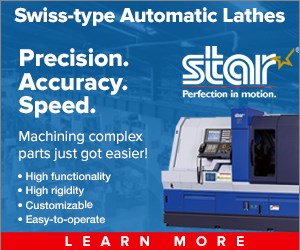What Would You Notice in Someone Else’s Shop?
If you’re an owner or manager of a CNC machine shop, do you get to visit other shops often? And, if so, what do you keep an eye out for?

I frequently visit CNC machine shops sharing with readers ways those shops leverage new technology to become more profitable. Email me if you feel yours is a machine shop I should consider visiting and profiling in the magazine.
I’ve spent the past 18 years visiting and writing about machine shops for Gardner Business Media, currently as editor-in-chief of the Production Machining brand. During my shop visits, I try to be the eyes and ears of shop owners and managers who often don’t get a chance to leave their shops to visit other facilities. I often wonder what they would look at or inquire about if they were on-site with me.
In fact, I’ve asked shop principals that specific question: When you visit other shops, what do you make it a point to notice? The types and brands of machine tools (and level of service and support) is one common and expected reply. But here are others I’ve gotten over the years.
- Workholding. This is by far the top answer. Is the shop using traditional workholding, fixturing, chucks and more that might take a good bit of time to change out? Or, is it using devices that offer quick-changeover capabilities to speed setups for new jobs? Batch sizes even for high-volume production shops are becoming smaller, so quick-change workholding can minimize downtime for what can be very expensive capital equipment, especially in our precision-turned parts industry.
- Work in process (WIP). How much partially completed WIP is queued up near machines waiting for those machines to become available to perform secondary operations? WIP is a form of waste. Shops using multitasking machining equipment are much less likely to have WIP throughout their shop because they have machines that can oftentimes complete parts in one setup. This could be as simple as CNC lathes with live tooling.
- Part handling/collection after machining. In a high-volume production machining environment using equipment that is commonly bar-fed, completed parts can be produced in short order. How are those parts collected so they don’t get damaged (or lost in the case for very small components) and is the means for part collection a bottleneck in a desired unattended machining process?
- Shop management software. How is the shop tracking work as it flows through its facility from raw material to completed parts ready for customer delivery? For any given job, how quickly can the shop identify where that job is relative to its completion? Enterprise resource planning (ERP) software is becoming more prevalent in shops to offer immediate visibility in that regard as well as improved scheduling and other advantages. The days of using spreadsheets are soon coming to an end.
- Tool management. Is there a central tool crib to manage and distribute tools to machine operators and setup personnel? Or, perhaps even better, is the shop using a vending system to track tool consumption and trigger tool purchases when inventory becomes depleted? There’s nothing much worse than thinking you have a tool on hand for a new job only to find out you don’t. And then you have to pay for expedited shipping to get that tool to your shop ASAP.
- Machine monitoring. Is the shop relying on gut feelings as it makes decisions as to how shopfloor processes should be adjusted or is it using data such as that pulled from machine tools to make more informed decisions? Even simply knowing and tracking when a machine’s spindle is cutting and when it isn’t in a given shift can be very helpful.
- Parts cleaning. Specifications for machined parts cleanliness continue to become more stringent. What process/processes is the shop using to meet those specifications. Many cleaning options are available, including those that eliminate the need for harmful chemical solvents, replacing those with a mostly aqueous method. Automated cleaning processes can be very helpful in high-volume production environments.
Read Next
Precision Machining Technology Moving Shops Forward
New equipment and software continue to be developed to support the needs of production machine shops like yours. Here’s a sample of technology now on the market that can help you grow your operation and become more efficient.
Read MoreIs 3D Printing in Your Shop or on Your Radar?
Recent shop visits reveal that some machining businesses have added/are considering adding 3D printing equipment, while others are content sending that work — for items such as polymer fixtures and jigs — to outside vendors.
Read MoreNon-Machining Processes Worth Considering
Here are three in-house processes outside of machining parts from which your shop, employees and customers could benefit.
Read More















